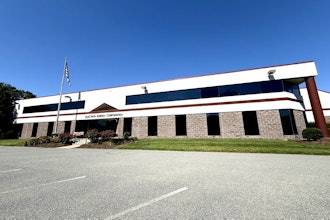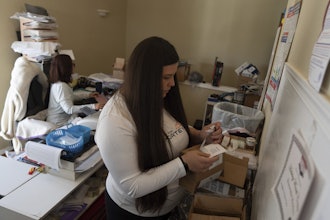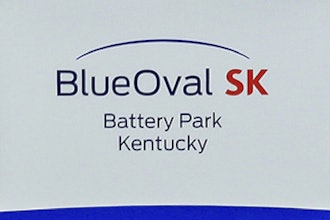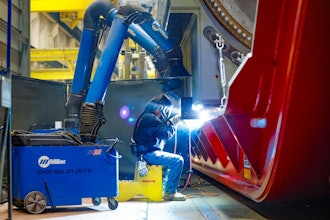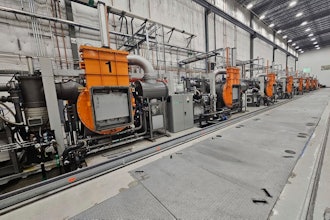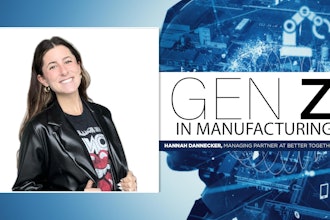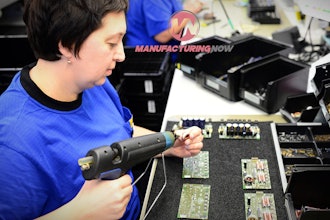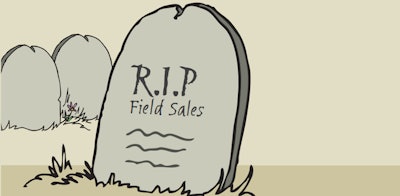
JUSTIN ROFF-MARSH
1
R.I.P
Field Sales
DEATH
OF FIELD
SALES
Bonus Chapter from The Machine
Justin Roff Marsh
Founder: Ballistix
www.salesprocessengineering.net
Bonus C
ha
pt
erA
ut
ho
r's
First
Draft
SA
MP
LER
BONUS CHAPTER
THE
2
THE MACHINE — SAMPLER JUSTIN ROFF-MARSH
3
INTRODUCING INSIDE SALES
This discussion is worthy of its own chapter for a couple of reasons.First, as you’re about to discover, the odds
are pretty good that you need an inside-sales team. And,
what’s more, the creation of this team should probably take
priority over whatever changes you plan to make to your
outside sales activities.
And, second, our discussion of inside sales – is going to
bring us face to face with a set of fundamental changes in
the way most markets function. And that’s not a bad place
to start.
THE DEATH OF FIELD SALES
As I write this, The death of field sales is my most
popular lecture topic. Most event organizers assume that
I exaggerate in order to capture busy executives’ attention.
Well, it’s true that headlines often benefit from a little
hyperbole, but there’s less exaggeration here than you
BONUS CHAPTER:
THE DEATH OF FIELD SALES
If you’d like to read more of
The Machine, be sure to subscribe
to Justin’s blog. There are more
chapters for you to read right now
and you’ll receive the rest in your
inbox as Justin completes them.
www.salesprocessengineering.net
Extract from:
THE
MACHINE
A radical approach to the
design of the sales function
4
THE MACHINE — SAMPLER JUSTIN ROFF-MARSH
5
might expect. In most markets, field sales is either dying,
or its dead already!
Of course, I’m not heralding the end of field salespeople.
There is a requirement for field salespeople in some (but
definitely not all) markets now – and there will always be
circumstances where face-to-face selling is indispensable.
What are on their way to extinction are environments
where sales is essentially an outside activity. Even in
engineer-to-order environments today (think JSG), only a
tiny percentage of the total volume of activities required to
originate and prosecute a sales opportunity are performed
in the field. And those important field activities would
simply not occur if it were not for the volume of work
performed inside.
The fact is, sales today is an inside endeavor, supported, in
some cases, with discrete field activities.
If you want proof, follow one of your field salespeople
around for a week. What you’re likely to discover is that
your field salesperson spends less than 10% of their time in
the field. The balance of their time will be spent in an office
of some kind (your head office, a branch office, a home
office or a makeshift office in the backseat of a rental car!).
If my prediction is correct, your field salesperson is not
really a field salesperson at all. They are an inside salesperson
who performs occasional field activities.
There are still some markets where sales is essentially an
outside activity. Trade tools, for example. Think of Snap‑on,
whose operators pilot their white, red and black trucks
direct to workshops and building sites and sell on the spot.
But, these markets are an exception, not the rule. It’s
rare, today, to find customers who are happy for salespeople
to drop-in, unannounced. Actually, in addition to making
drop-ins impossible, most organizations go to quite some
effort to rebuff even those salespeople who are polite
enough to attempt to schedule a meeting in advance!
We have technology to blame for this disturbing state
of affairs.
Fifty years ago, an organization’s (potential) customers
were out there, in the field. Relative to today, they were
isolated from their vendors. This is before fax machines
and PBX’s were pervasive, and certainly before, email,
websites and instant messaging. Salespeople bridged
this geographic divide by visiting with customers in
the field – and by ferrying information back and forth
between their head offices and customers’ locations.
Today, customers are no longer isolated from their
vendors. Vendors’ organizations are as close as the
nearest web browser. And fax machines, private lines,
email and instant messaging have made it easier for
customers to communicate with representatives in
organization’s head offices than it is to communicate
with their salespeople!
That’s right, where field salespeople historically served
to reduce the friction between vendors and their customers,
today, it’s more likely that salespeople add friction! Certainly,
it’s quite common to hear customers complaining that they
can get better information and faster outcomes if they side-
step salespeople and communicate direct with vendors’
head-office customer-service teams.
Salespeople have responded to this situation with a
mixture of defiance and pragmatism.
Most, as suggested earlier, have retreated inside, where
they can be more productive. If they’re not welcome in
corporate offices, they have built their own home offices.
But, these same salespeople (and their managers), will
vehemently defend the traditional model, when challenged.
Even in environments where most transactions are repeat
purchases of commodity products, salespeople will argue
that sales is essentially a field activity and that customers
6
THE MACHINE — SAMPLER JUSTIN ROFF-MARSH
7
should be prepared to pay a premium for the value that
field salespeople add!
Rather than wading into that argument, let’s take a
moment to view sales from the customer’s perspective.
Ask yourself: if you are making a purchase (of an
unspecified nature), is your default starting point to look
for a person who can come and visit with you in the field?
I suspect not!
It’s more likely that your first instinct will be to
turn to a medium that enables you to purchase with no
human contact whatsoever (if one exists).
If you need to communicate with a human in order
to make your purchase, you’ll probably prefer a phone
conversation to a face-to-face visit (unless the latter is
critical for some reason). And, even if a face-to-face
visit is critical, there’s a good chance that you’d rather
visit the salesperson than have one come to your home
or place of work.
Now, you might argue that I’ve stacked the deck in
my favor by failing to specify the nature of the purchase:
after all, isn’t there a difference between purchasing a set
of replacement razor blades and purchasing a custom-
engineered software application?
Let’s explore that.
In the case of the replacement razor blades, it’s clear
that there’s no value in human contact. I think most
people would rather make the purchase in a single click
on Amazon.
But, in the case of the custom-engineered software
application, isn’t it clear that you’d need to interact with
a salesperson, face-to-face?
Sure. But it’s pretty unlikely that this is where your
purchasing process would start. It’s more likely that
you’ll start with online research. Then, at your leisure,
you’ll have one or more conversations with telephone
advisors. While it’s clear that, at some point, you’ll
schedule one (or more) face-to-face meetings, it’s
likely that you will defer these meetings until there’s
a requirement for a conversation that genuinely needs
to be performed face-to-face (a hands-on workshop,
perhaps). And, for the record, such a conversation is
likely to have a strong technical component.
It’s easy to see how the ( JSG) sales model described
in the first two chapters of this book is appropriate in
engineer-to-order environments (custom-engineered
software, for example).
However, it’s important to recognize that transactions
of this nature are a small percentage of total transactions
for most organizations. Even in the case of an organization
that sells only custom software, there are likely to be
transactions that are simple in nature (e.g. the addition of
small features to existing applications).
It’s time now to envision the kind of sales function that
will support your (and most likely, your clients’) preferred
approach to purchasing.
THE INSIDE-OUT APPROACH
This fundamental change in market dynamics requires
that we make an ideological shift. The salesperson’s
pragmatism won’t cut it. We need to embrace this change
and recognize that, today, sales is essentially an inside
activity.
Where planning is concerned, what’s required is an
inside‑out approach. Start with an inside sales function and
then add field resources as they are required – and only to
the extent that they are required.
8
THE MACHINE — SAMPLER JUSTIN ROFF-MARSH
9
Customer service
The inside-out approach starts by paying attention to
the type of transactions that make up the lion’s share of a
typical organization’s revenue.
These are simple – typically repetitive – transactions.
For the purpose of this book, we’re not treating these
transactions as sales but they’re critical, nonetheless.
These simple transactions should be the responsibility of
customer service, along with the generation of quotations
and handling of customer issues. (A percentage of these
transactions should actually bypass customer service and go
direct to ecommerce, but that’s outside the scope of this
book.)
Customer service should triage all telephone inbound
traffic and intercept all simple orders, requests for quotes
and issues. Customer service should have sufficient
protective capacity to enable the team to handle peak loads
and to ensure that no one else in the organization need ever
process an order, generate a quotation or handle a customer
issue.
Inside sales (and campaign coordination)
Once customer service has control over simple
transactions, most executives assume that the next team to
add is field sales.
There are two problems with jumping straight to field
sales.
First, field sales is incredibly expensive (on a per‑
selling‑conversation basis) relative to inside sales. An
inside salesperson can comfortably have 30 meaningful
selling interactions (including email) a day, where a field
salesperson will work hard to average 4 meetings.
Second, if you start with field sales, you will turn your
back on a number of selling interactions that you could
have had but will not have if you insist that each prospect
accepts a field visit.
And this is a critical point!
It’s easy for sales managers to argue (as they do) that
field meetings are more effective than phone conversations.
However, this argument ignores the fact that, an insistence
on field meetings results in salespeople having fewer selling
conversations overall.
10
THE MACHINE — SAMPLER JUSTIN ROFF-MARSH
11
Our inside-sales team actually consists of two roles.
We have the inside salespeople – who perform nothing
other than what we call meaningful selling interactions.
These interactions include phone conversations, email
communication and even instant messaging. Of course
inside salespeople do not generate quotes or enter orders –
these tasks are routed to customer service.
We also have a campaign coordinator – who is
responsible for generating all of the outbound sales
opportunities that keep the inside sales team members so
busy. (Some inbound opportunities are escalated to inside
sales from customer service.) The campaign coordinator
ensures that inside salespeople always have calls to perform
and avoids inside salespeople hunting and pecking for sales
opportunities within CRM.
Field specialists
Once you have an inside sales team, you should continue
to resist the temptation to add field salespeople for just a
little longer!
When you consider the incredible productivity
differential, you should make sure that you’ve fully exploited
the potential of inside sales before you add (traditional)
salespeople.
So let me unpack that somewhat opaque advice for you!
By exploit the potential of inside sales, I mean, keep adding
inside salespeople until the revenue you expect your next
salesperson to generate approaches their total cost.
And, with the phrase traditional salespeople, I’m hinting
that it might be possible to use a special breed of salesperson
to further exploit the capability of inside sales.
12
THE MACHINE — SAMPLER JUSTIN ROFF-MARSH
13
A field specialist is a person who supports inside sales by
performing discrete field activities. These activities are likely to be
technical or semi-technical in nature. Typical activities include
on-site requirement discovery and product demonstrations. The
field specialist can also perform field visits that are requested of
them by the customer service team.
Unlike a salesperson in an engineer-to-order environment
(think, Jennifer), field specialists are not primarily responsible
for critical selling conversations – they are the responsibility of
the inside sales team. Rather, the field specialist is responsible
for performing field activities that would otherwise block the
inside sales team from selling.
Business development
Once you have fully exploited the potential of inside
sales, both by growing the team and by supporting inside
salespeople with field specialists, it’s now time to consider
traditional field salespeople.
And, as you learned in the previous chapter, field
salespeople (business-development managers) are an order
of magnitude more productive when we partner them with
dedicated coordinators.
14
THE MACHINE — SAMPLER JUSTIN ROFF-MARSH
15
We now have an outline of the entire inside‑out sales
function (at least at a conceptual level). We also have an
understanding about how, in practice, it makes sense to go
about building your sales function.
In short, start with customer service and only add
additional components when you are sure you have fully
exploited the existing ones.
WHAT IS THE POTENTIAL OF INSIDE SALES?
Many executives are uncomfortable with this approach
because it’s based on an assumption that inside salespeople
are capable of making many of the sales that are currently
being made by field salespeople today.
In my experience, this assumption is absolutely valid.
There are situations where face-to-face selling
conversations are absolutely critical. But there are many
more situations where they are simply not. And, as
discussed earlier, an overestimation of the requirement
for face-to-face meetings tends to result in a much lower
overall volume of selling conversations.
It’s helpful to consider the two situations where face-
to-face meetings are genuinely required.
A face-to-face meeting is critical when there
are activities to be performed that simply cannot be
performed (effectively) remotely. An obvious example
would be a meeting between an architect and a land
owner to canvas ideas about how to exploit the features
of a piece of land. Another example would be a full-day
strategic-planning workshop.
A face-to-face meeting can also be very beneficial
when a potential client is contemplating a purchasing
decision that involves high levels of uncertainty. For
example, if you are not a lawyer and you are considering
appointing a lawyer to represent you in a particularly
important case, you would feel compelled to meet your
proposed counsel face to face. As a non-lawyer, you
lack the ability to make an objective assessment of the
individual’s professional capabilities and you have little
choice (for better or worse) but to use your assessment of
the person as a proxy for their professional capabilities.
Our experience is that conversations that do not fall into
one of these categories are better performed by telephone
(or email) and, increasingly, this is what potential clients
prefer.
Furthermore, if you think about it, each of the face-to-
face conversations described in the two categories above
will undoubtedly have been preceded by quite a number
of non-face-to-face conversations. In the inside-out model
described in this chapter, those preliminary conversations
would either have been performed by an inside salesperson
or by a business-development coordinator (or both),
depending on the environment.
In summary, then, it’s likely that a good percentage of
your sales opportunities do not require field visits at all.
And, of those that do, only a small percentage of the total
conversations performed, will be performed in the field.
Furthermore, of the total field visits required, it’s likely
that a good number of them do not involve true selling
conversations (these are the visits that consist of on-site
requirements discovery or product demonstrations).
Where the staffing of your sales function is concerned,
this has two implications.
You need very few field representatives – and of the
field representatives that you do need, most will be field
specialists. Which, in turn means that it will be easier for
you to justify spending the bigger dollars you will inevitably
need to spend to attract the small number of capable
16
THE MACHINE — SAMPLER JUSTIN ROFF-MARSH
17
enterprise-class salespeople that you need in your few
remaining business-development manager positions.
The other implication, of course, is that you need a
larger inside sales team. The good news is that this enables
you to exploit some economies of scale. A lively, fun
inside-sales environment will be a lot more appealing to
a broader range of candidates then a rolodex and a rental
car. Additionally, a larger team of (co-located) individuals
will be much easier to manage and, consequently, may even
enable you to justify the addition of a high-powered inside-
sales supervisor (which can have an enormous impact on
team performance).
WHO ARE THESE INSIDE SALESPEOPLE?
Let me start by stressing who these inside salespeople
are NOT.
Your inside-sales team members are not telemarketers
(in the traditional sense of the word). They are true
salespeople: equivalent, in every sense, to the type of person
who you would otherwise have in the field.
They are knowledgeable, ambitious and engaging. And,
they are paid roughly what they would expect to earn if
they were field salespeople.
And, importantly, your inside-sales team members are
not second-class citizens, relative to your field specialists.
Your inside sales team, if your organization is typical, is
your primary sales team and it’s vital that this is reflected in
your cultural norms.
As hinted above, this shift in focus to inside salespeople
will give you more degrees of freedom when it comes to
attracting talent. You can attract capable people (perhaps
from a technical background) who would simply not be
interested in operating in the field. What’s more, because
you have team members operating in close proximity to one
another, it’s easier for you to introduce lessor experienced
candidates – meaning that you can employ younger team
members or recruit people from outside your specific
industry.
This chapter completes your understanding of what we
call our standard model.
This model is a blend of customer service, inside
sales (supported by the campaign coordinator and field
specialists) and business development (supported by project
leaders).
In Chapter 6 we’ll talk about alternative models, and
provide insight into how to apply the four key principles
to design applications of SPE for different environments.
But first, it’s time to reflect on the integration between
sales and the rest of the organization.
18
THE MACHINE — SAMPLER
THE
MACHINE
A radical approach to the design of the sales function
Justin Roff Marsh
Founder: Ballistix
www.salesprocessengineering.net
© 2015 Ballistix
BONUS CHAPTER: The death of field sales
If you’d like to read more of
The Machine, be sure to subscribe
to Justin’s blog. There are more
chapters for you to read right now
and you’ll receive the rest in your
inbox as Justin completes them.
www.salesprocessengineering.net













